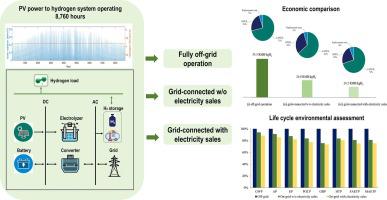当前位置:
X-MOL 学术
›
Energy Convers. Manag.
›
论文详情
Our official English website, www.x-mol.net, welcomes your
feedback! (Note: you will need to create a separate account there.)
Strategy-based optimization and life cycle environmental impact assessment of a stable photovoltaic power-to-hydrogen system
Energy Conversion and Management ( IF 9.9 ) Pub Date : 2024-07-01 , DOI: 10.1016/j.enconman.2024.118747 Yu Gu , Qianqian Chen , Danfeng Wang , Zhiyong Tang
Energy Conversion and Management ( IF 9.9 ) Pub Date : 2024-07-01 , DOI: 10.1016/j.enconman.2024.118747 Yu Gu , Qianqian Chen , Danfeng Wang , Zhiyong Tang

|
With the growing global emphasis on reducing greenhouse gas emissions and transitioning to a low-carbon economy, renewable hydrogen is expected to play a vital role in the chemical industry. However, there is a contradiction between the continuous and stable hydrogen demand of chemical process systems and the intermittent and fluctuating nature of renewable energy systems when coupling them together in the industrial chemical production. There are currently few studies addressing year-round stable hydrogen load systems while considering renewable energy intermittency and capacity optimization. Moreover, the comprehensive life cycle environmental impact study of such stable renewable-hydrogen production system is extremely limited. Therefore, this study focuses on a photovoltaic power-to-hydrogen system that can operate stably for 8,760 h per year, specifically targeting its application in the chemical industry. Two operating strategies of the hydrogen system were considered: fully off-grid and ultra-light grid-connected scenarios. The capacity configuration under each scenario was optimized using gird search algorithm, with the objective of minimizing the levelized cost of hydrogen. Based on the optimization results, the energy flow network, cost-effectiveness, and comprehensive life cycle environmental impacts of such system were analyzed. The results show that the ultra-light grid-connected hydrogen production system, due to the support of the power grid, has improved the reliability of the hydrogen production system and significantly reduced the capacity configuration of system components, thereby demonstrating better performance in terms of economics and overall lifecycle environmental impact compared to a completely off-grid hydrogen production system. Its global warming potential (GWP) and levelized cost of hydrogen under electricity sales scenario are 12% and 31% lower, respectively, compared to fully off-grid hydrogen production. Considering China’s future demand for large-scale renewable hydrogen, ultra-light grid-connected hydrogen production may become the primary transitional pathway in the near to medium term.
更新日期:2024-07-01

















































 京公网安备 11010802027423号
京公网安备 11010802027423号